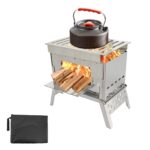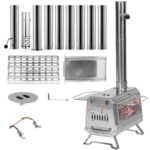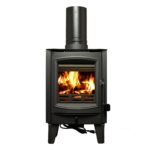
Introduction to Mini Wood Stoves
Mini wood stoves are innovative heating solutions specifically designed for small living spaces such as tiny houses, cabins, and reduced-footprint dwellings. These compact stoves utilize wood as a sustainable fuel source, offering an efficient and eco-friendly method of heating, which has become increasingly popular among those seeking alternative, off-grid lifestyles.
The primary purpose of a mini wood stove is to provide heat in an efficient and effective manner while maximizing limited space. Unlike traditional heating methods—which often rely on electricity or gas—mini wood stoves harness the natural energy of burning wood, thus reducing reliance on fossil fuels. By producing a significant amount of heat relative to their size, these stoves ensure that tiny homes remain comfortably warm during colder months without occupying an excessive amount of square footage.
One of the key benefits of mini wood stoves is their ability to heat a small area quickly and consistently. Their design often incorporates advanced combustion technology, which enhances efficiency by burning wood thoroughly, resulting in less smoke and fewer emissions. Additionally, they are generally easier to install and maintain compared to larger heating systems, making them ideal for the compact nature of tiny homes.
Furthermore, mini wood stoves offer an aesthetic appeal that complements the design of small living spaces. Available in various styles and finishes, they can serve as a focal point within a room while providing the necessary warmth. In essence, mini wood stoves represent a practical and efficient heating solution, particularly well-suited for those who desire to maximize space without sacrificing comfort or environmental responsibility.
Benefits of Using a Mini Wood Stove
Mini wood stoves have gained popularity among tiny house dwellers for several compelling reasons. One of the most significant advantages is their energy efficiency. These stoves are designed to maximize heat output while minimizing fuel consumption. By using a mini wood stove, homeowners can heat their small spaces effectively, translating to lower energy bills. Compared to traditional heating systems, these stoves often require less wood, making them a cost-effective solution during colder months.
Cost savings extend beyond just energy expenses. With rising utility prices, the affordability of wood as a fuel source cannot be overlooked. Many people find it more economical to purchase or source firewood, especially if they utilize local suppliers or their own land. Furthermore, several states offer tax incentives for using renewable energy sources, including wood, which can further reduce costs associated with heating a tiny home.
Environmental sustainability is another notable benefit of mini wood stoves. Wood is considered a renewable resource, and when harvested responsibly, it has a minimal environmental impact compared to fossil fuels. As long as wood is sourced from sustainably managed forests, using it as a heating source helps in reducing carbon emissions. This directly contributes to a more sustainable lifestyle, which is especially important for those choosing to live in tiny homes.
Beyond practical advantages, the ambiance created by a mini wood stove adds invaluable charm to a tiny house. The heartwarming glow of the fire invites relaxation and contributes to a cozy atmosphere, often becoming a focal point around which family and friends gather. This comforting ambiance not only enhances the quality of life but also creates cherished memories, thereby reinforcing the emotional benefits associated with a mini wood stove in any tiny living space.
Choosing the Right Mini Wood Stove for Your Tiny House
When selecting a mini wood stove for your tiny house, several essential factors must be considered to ensure effective heating and a seamless fit with your living space. The first aspect to evaluate is the size of the stove. A mini wood stove should be appropriately sized to fit within the limited square footage of a tiny home while also providing sufficient heat output to maintain a comfortable environment. Ideally, you should measure the square footage of your living area and choose a stove that matches the heating capacity suitable for that space.
Next, consider the heating capacity of potential models. Mini wood stoves vary in their BTU output, which influences how effectively they can heat your home. A higher BTU rating typically means that the stove can heat a larger area. However, for tiny houses, efficiency is key; therefore, look for stoves designed specifically for smaller spaces, as they balance size and power adeptly.
Another critical aspect is the material used in the construction of the stove. Common materials include cast iron, steel, and ceramic. Each material has distinct advantages—the durability of cast iron, for example, may outweigh its weight, while steel offers lighter weight and faster heating. Ensure that the material chosen aligns with your heating needs and maintenance preferences.
Installation requirements should also be a priority in your decision-making process. Ensuring that the mini wood stove fits within your existing layout and meets local building codes is paramount. This could involve consulting with a professional to assess ventilation needs and clearance spaces. Popular brands like Cubic Mini, The Hamlet, and Dickinson are notable for providing reliable stoves that cater well to tiny house living.
Lastly, identifying your tiny house configuration will help narrow down your options further, ensuring seamless integration of the chosen wood stove into your living space. By carefully assessing these factors, you can select the ideal mini wood stove, achieving the warmth and comfort desired in your tiny home.
Installation Requirements for Mini Wood Stoves
When it comes to installing mini wood stoves in tiny houses, there are several critical requirements that must be addressed to ensure safety and efficiency. The first consideration is the flue size. It is essential to choose a flue that matches the diameter recommended by the stove manufacturer. An inadequate flue size can lead to poor draft and increased creosote buildup, which poses a fire hazard. Adhering to these specifications is crucial for optimal performance.
Chimney installation is another vital aspect of the installation process. A properly installed chimney must extend at least three feet above the roofline and at least two feet higher than any structure within ten horizontal feet. This setup promotes effective ventilation, allowing smoke to exit the tiny house safely. It is advisable to use insulated chimney pipes, especially in colder climates, to prevent condensation that can lead to flue blockages.
Clearances from combustible materials are equally important when installing a mini wood stove. Each stove will have specific clearance requirements outlined in its manual. Generally, stoves should be positioned at least 36 inches away from combustible walls or furniture. This includes any decorative items that may inadvertently become hazards. It is recommended to use heat shields or non-combustible materials to mitigate the risks associated with heat transfer.
Ventilation standards also play a critical role in the safety and effectiveness of mini wood stoves. Adequate air supply is necessary for combustion, and homes should be designed with sufficient ventilation to facilitate airflow. Installing the stove in accordance with local building codes will help ensure compliance and safety. Engaging a professional for installation is often wise, as they bring expertise that can prevent potential pitfalls.
Fuel Options for Mini Wood Stoves
When selecting a mini wood stove, understanding the various fuel options available is critical for optimizing efficiency and comfort in your tiny house. The primary types of wood fuel suitable for these compact heating units include split firewood, wood pellets, and alternative biomass fuels. Each option presents unique advantages and disadvantages, influencing the overall performance of the stove and the heating experience within your living space.
Split firewood is perhaps the most traditional fuel choice and involves logs that have been cut and split for burning. This option typically produces a significant amount of heat and is generally more affordable than processed fuels. However, it requires adequate storage space, proper seasoning to ensure moisture content is low, and frequent loading into the stove. The preparation and maintenance of split firewood can be labor-intensive, especially in smaller living spaces.
Wood pellets are another favored alternative, made from compressed sawdust and wood shavings. These pellets are uniform in size and have a high heat output while producing minimal ash compared to split firewood. Wood pellets can be more convenient, requiring less frequent refueling and producing cleaner combustion. However, sourcing quality pellets can be an ongoing concern, and they typically require a dedicated feeder system for optimal use in a mini wood stove.
In addition to traditional wood options, alternative biomass fuels, such as corn, nut shells, or even recycled paper products, are worth considering. These materials can offer unique burning characteristics and, in some cases, are sourced from sustainable practices. However, their availability may vary, and performance can be inconsistent. Regardless of your choice, ensuring proper storage conditions for your chosen fuel will help maintain its quality and ensure a reliable heat source throughout the colder months.
Maintenance Tips for Your Mini Wood Stove
Proper maintenance of your mini wood stove is essential for ensuring its efficiency, safety, and longevity. Regular upkeep can also enhance the overall experience of using your stove, particularly in a tiny house setting where space and resources are often limited. Here are several practical maintenance tips to consider.
First and foremost, cleaning your wood stove should be a routine task. A clean stove not only performs better but also reduces the risk of dangerous creosote buildup in the chimney. It is advisable to clean the stove thoroughly at least once a month during peak usage seasons. This includes removing ash and debris from the firebox, cleaning the glass door, and ensuring that the air vents are unobstructed. Use a damp cloth to wipe down surfaces and a specialized stove cleaner for stubborn residue.
Checking for leaks is another critical aspect of maintenance. Inspect the seams and joints of your mini wood stove for any signs of smoke or air leakage. A leak not only reduces efficiency but can also pose a safety risk. If you detect any issues, consider using high-temperature silicone sealant to repair them or consult a professional for assistance.
Seasonal maintenance routines play a significant role in the longevity of your stove. Before winter, ensure that your chimney is clean and clear of obstructions. Scheduling a professional inspection of your chimney and flue annually can prevent potential hazards and improve performance. Additionally, always check that the stove’s gaskets are intact and provide a good seal, as worn gaskets can lead to air leaks and decreased efficiency.
Finally, it’s important to be aware of signs that your stove may need professional servicing. If you notice unusual smoke, a decrease in heat output, or strange noises, these could be indicators of an underlying problem. Addressing these issues promptly can help maintain the functionality and safety of your mini wood stove.
Safety Considerations When Using Mini Wood Stoves
When utilizing a mini wood stove in a tiny house, it is imperative to prioritize safety to ensure a secure and comfortable living environment. Proper installation is the foundation of safe stove operation. It is crucial to follow manufacturer’s guidelines and regional building codes to prevent potential fire hazards. The stove should be installed on a non-combustible surface, and flues must be correctly fitted to ensure efficient exhaust of smoke and gases.
Choosing appropriate fuels is another vital safety measure. Only seasoned hardwood or approved fuels recommended by the stove’s manufacturer should be used. Burning treated wood, plastics, or paper can produce harmful emissions and create dangerous creosote buildup in the chimney, significantly increasing the risk of chimney fires. Regular checks of fuel sources are necessary to prevent the use of unsuitable materials.
Ventilation must be adequately considered when using a mini wood stove, particularly in small spaces. A well-ventilated area allows for sufficient air exchange, which is vital to maintaining optimal combustion and preventing carbon monoxide accumulation. Installing outside air intake can further improve airflow and enhance the efficiency of the mini wood stove.
Moreover, homeowners should invest in essential safety devices, including smoke detectors and carbon monoxide alarms, to monitor for any dangers associated with wood-burning appliances. It is crucial to ensure these devices are regularly maintained and tested to ascertain they are functioning correctly. A dedicated emergency plan and routine maintenance checks on the stove’s components can further mitigate risks.
By prioritizing these safety considerations during the use of a mini wood stove, individuals can experience the warmth and comfort of their tiny home while minimizing potential hazards.
Alternative Heating Solutions for Tiny Homes
When considering heating options for tiny homes, various alternatives are available alongside mini wood stoves. Among the most common are propane heaters, electric heaters, and solar heating systems. Each has distinct characteristics that can influence a homeowner’s choice based on factors such as efficiency, environmental impact, and installation requirements.
Propane heaters, for instance, are popular due to their ability to provide heat quickly and efficiently. These heaters can be easily installed and typically require minimal maintenance. However, they depend on a supply of propane, which can lead to recurring costs and potential hazards related to gas leaks. Additionally, reliance on propane may not align with sustainability goals for some tiny home owners.
Electric heaters present another viable alternative. They are straightforward to use, with various types available, including baseboard heaters, wall-mounted units, and portable options. Electric heating can be excellent for small spaces, but it may have limited effectiveness in extremely cold conditions. Moreover, the cost of electricity can vary significantly, potentially making electric heaters less economical in the long run.
Solar heating systems are increasingly gaining traction among environmentally conscious tiny house dwellers. These systems utilize solar panels to harness the sun’s energy, providing a renewable heating solution. While this option can significantly reduce utility bills, significant upfront costs for solar panel installation can be a barrier for some homeowners. Furthermore, the effectiveness of solar heating can fluctuate depending on geographical location and weather patterns.
In conclusion, while mini wood stoves offer a unique blend of warmth and ambiance, examining alternative heating solutions—such as propane heaters, electric heaters, and solar heating systems— is crucial in determining the best fit for your tiny home. Each option carries its own set of advantages and challenges, making it essential for homeowners to weigh their priorities and assess their specific needs before making a decision.
Personal Experiences and Testimonials
Many tiny house owners have embraced mini wood stoves as a primary source of heating, finding them not only efficient but also a charming focal point in their compact living spaces. One homeowner, Sarah, shared her experience of installing a mini wood stove in her 200-square-foot cabin. She noted that the wood stove provides warmth that is both efficient and effective, allowing her to maintain a comfortable temperature even during the coldest winter months. Sarah appreciates the ambiance created by the flickering flames, enhancing the cozy atmosphere of her tiny home.
Another tiny house dweller, Mark, highlighted the affordability of heating with wood compared to traditional energy sources. After switching to a mini wood stove, he found a significant reduction in his heating bills. Despite the initial investment in the stove and necessary installation, he reported that the long-term savings outweighed the upfront costs. Mark also emphasized the sustainability aspect of using a wood stove, as he sources his wood locally, which aligns with his eco-friendly lifestyle choices.
However, the experience is not without challenges. Linda, a tiny house owner, mentioned the maintenance involved in keeping her mini wood stove functioning optimally. She described the process of regular cleaning and the importance of using seasoned wood to minimize creosote buildup. Additionally, Linda pointed out that finding the right balance between wood storage and living space can be tricky. Yet, she firmly believes that the benefits of having a functional and aesthetic heat source far outweigh these challenges.
Overall, many tiny house owners express satisfaction with their decision to invest in mini wood stoves. The combination of efficiency, comfort, and the unique character they bring to a small living space makes them a popular choice among those seeking warmth in their tiny homes. As prospective buyers consider their options, these testimonials illustrate the practicality and charm that mini wood stoves can offer.
Conclusion: Embracing the Comfort of Mini Wood Stoves
As we explore the challenges and solutions associated with heating tiny homes, it becomes evident that selecting the appropriate heating system is paramount. Among the various options available, mini wood stoves emerge as a favored choice for many homeowners seeking efficiency and warmth. The compact design of these stoves allows them to fit seamlessly into small living spaces, making them an ideal solution for tiny house dwellers.
Mini wood stoves are not only efficient in their heat output, but they also embody a sense of comfort and ambiance that is often sought after in a cozy living environment. Their ability to utilize renewable resources aligns with the increasing trend toward sustainable living. By choosing mini wood stoves, homeowners can reduce reliance on traditional heating systems and diminish their carbon footprint, all while enjoying the crackling sound and soothing glow of a fire.
Moreover, the variety of designs and styles available makes it simple for homeowners to select a mini wood stove that complements their decor and meets their heating needs. Whether opting for a classic cast iron model or a sleek modern design, each choice offers unique benefits tailored to diverse preferences and requirements. It is crucial for potential buyers to consider both the heating capacity and the stove’s efficiency ratings to select the best fit for their specific space.
In conclusion, as you contemplate the most suitable heating solution for your tiny home, mini wood stoves should be at the forefront of your considerations. With innovative designs, efficient operation, and the ability to create a welcoming atmosphere, these stoves provide an excellent option for anyone looking to embrace comfort without sacrificing style or sustainability. Investing in a mini wood stove may well be one of the best decisions for enhancing your tiny house experience.





